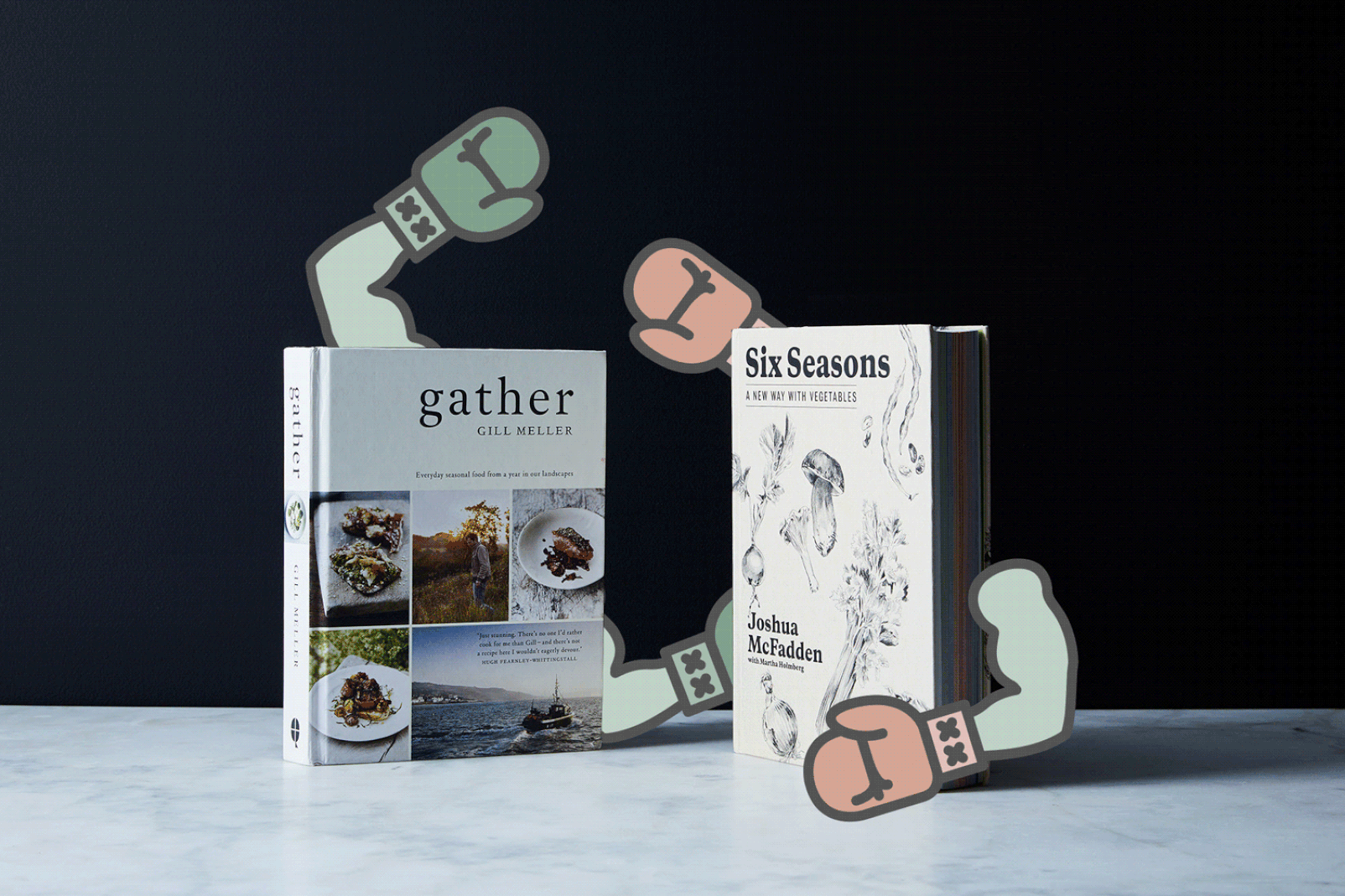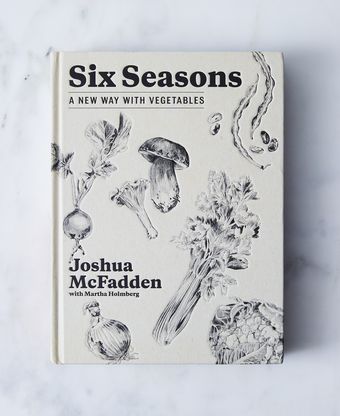There are so many cookbooks in my house that a friend suggested I start making furniture from them. I literally wade through stacks of them from my front door, up the stairs that are lined with books, through the living room to the kitchen. And yet, I managed to miss these two. Shame on me. Especially since they are both farm-to-table books, a genre around which my professional life is in tight orbit. I regularly shop at farmers’ markets, since I’m lucky enough to live in Los Angeles, and I am accustomed to—in fact prefer—ingredient-driven cooking.
Or do I say “cookery”? One of these competitors, Gather: Everyday Seasonal Food from a Year in Our Landscapes by Gill Meller, is a UK publication. Meller belongs to the coterie of culinary rustics associated with the River Cottage, a place of idyllic farm-to-table dreams, which hosts event dinners, cookery classes and perhaps your wedding! This is his first book, with lush imagery by photographer Andrew Montgomery. I’ve been harboring a persistent dream of escaping to an English cottage with an Aga, where I can cook and bake and watch lambs cavort in the drizzle. I am ready to be won over.

My other book is Six Seasons: A New Way With Vegetables by Joshua McFadden with Martha Holmberg. McFadden is an American chef from the Midwest who has a small restaurant group in Portland, Oregon. He opened his first place, Ava Gene’s, after cooking at many restaurants known for their farm-to-table pedigree (Blue Hill, Franny’s, and Momofuku in New York). He also spent time running Four Season Farm in Maine, an operation akin to River Cottage writ small.
So here I am, about to cook from two cookbooks that speak the same language but come from very different cultures. I should say at the outset that I am constitutionally incapable of following a recipe, including my own. However, I do cook nearly every night, so the opportunity to discover another palate I can plunder for my own daily inventory is strong.
First, let’s look at how the books are structured. Gather is organized by place. So in addition to Farm, there are chapters on Seashore, Garden, Orchard, Field, Woodland, Moor (really?) and Harbour. Under Woodland, there is a section on Squirrel. (I’m not going to be using those recipes.) Six Seasons is organized around, well, seasons, with an extra two thrown in for good measure because on the left coast there are usually more than four. As a frequenter of farmers’ markets, I’ve found seasonally organized cookbooks allow me to get inspired before I shop; I can come prepared.
The first recipe I attempted from Gather was the first one in the book because by some miracle, I had all the needed ingredients. Its title—Blue Cheese with Honey, Thyme, Dates, Fried Onions & Seeds—is nothing if not thorough, and I was eager to make the dish. One of my standard appetizers is goat-cheese stuffed dates dipped in pistachios, and this salad seemed like its cousin. It’s from the Farm section of the book, although dates are more Orchard (I guess Meller is leaning on the blue cheese for this categorization). It’s quickly thrown together: The only cooking involved is a saute of onions with thyme and pumpkin seeds. The set-up of the dish is a bit overly considered, though: You scatter the cheese, dates and warm onion combo separately over the plates, then drizzle the honey and mix it up together on each plate. Then you separately make the oil and vinegar dressing and drizzle that over the salads. The result was strangely in-your-face, with a distinct lack of balance between the sweet dates, cooked onion, and the sharpness of the blue cheese (even though I used a mild, creamy blue). The crunch of the seeds wasn’t pronounced enough. We didn’t finish our plates. Maybe it would work in small doses atop a crostino?

Finding disappointment in my first Gather foray, I moved on to the next recipe, also from Farm: Yogurt & Cardamom Sorbet with Brown Butter & Poppy Seed Shortbread. It’s really a frozen yogurt—and one of the most delicious creamsicle experiences I’ve had. I’ll definitely make it again, even though I was handicapped by my lack of an ice cream maker. I simply froze the mixture until it was slushy, used my food processor to beat it, then froze it again. The combination of orange zest and cardamom was subtle and had a synergy I didn’t expect. I meant to share it but ate the entire quart myself in two sittings.
Unfortunately, I had a problem with the accompanying shortbread. Perhaps part of the problem was the UK/American ingredient difference. The recipe called for golden superfine sugar. Not having the prescribed sugar, I instead took some light brown sugar and pulverized it further in my food processor. The technique calls for making brown butter, pouring it over the sugar in a bowl, then incorporating that with the flour/cornstarch mixture to form a “soft dough.” Mine was not a dough, not even a soft one. It was a batter and remained one even after I added more flour. I loved the garnish of poppy seeds, but the resulting shortbread tasted too much of cornstarch, was unpleasantly greasy, and fell apart too easily. Strike two.
Next up, a dramatically deep-colored autumn salad of Fried Pears with Roast Red Onions & Crisped Puy Lentils. It is logically (this time) located in the Orchard section of the book, with the seasonal indication “summer” (not so logically...well, maybe in Britain?). It’s a lovely recipe, although I’m not a huge fan of the new trend of leaving pulses a bit crunchy—as in, undercooked.
Time to dig into Six Seasons. I had turnips in the fridge, so I looked them up (Late Season) and found Half-Steamed Turnips with Alla Diavola Butter. In the dish’s headnote, Joshua says that kimchi was his inspiration. He creates kimchi-like flavors by making a compound butter with smoked paprika, peperoncini, chile flakes, cracked pepper and Tabasco. I made an executive decision to instead use finely minced kimchi, which I had on hand, with butter. I followed the directions to saute the turnips, then steam them with sequential additions of water. This is a way I cook veg a lot and his directions for it were spot-on. I added the kimchi butter and tossed. The turnips were delicious. I had leftovers and used them in an udon soup. When a primary recipe can become part of a second recipe, it’s always a win.
Moving on, I tackled Cauliflower Steak with Provolone and Pickled Peppers. Photographer Laura Dart’s shot of the dish was gorgeous in that casual-yet-perfect Ottolenghi way. I was intrigued by the idea of using a cauliflower as a platform for garnish. While you’re roasting the steaks, you’re putting together a mixture of breadcrumbs, cheese, and piquant peppers, which is added atop the slabs of cooked cauliflower. After a quick browning, it’s ready. This is one of those dishes that can easily be adapted to what you have in the fridge; I’ll be making it at least once a week forever.

The same night, I made the Roasted String Beans and Scallions with Pine Nut Vinaigrette. It’s essentially a roasted green bean salad. Trimming the scallions the same size as the beans and roasting them together is a smart conceit. Meanwhile, you’re making a sharp dressing that’s creamy from the toasted pine nuts. A quick toss with soft herbs like mint and basil adds freshness. I can imagine using that dressing the way you would a tahini dressing—or even as a drizzle over a plate of pesto pasta.
All in all, both books are worth the investment. Each provides a photograph for every recipe and good writing about the connection between land, plate, and human. My biggest complaint about Gather is that it focuses too much on landscapes most of us have no access to (woodland, moor) or ingredients that are difficult to source; but I’m unrepentantly urban and very unlikely to prepare game and other more “wild” ingredients at home. I’d rather go to a restaurant for those kinds of dishes–and I’d rather see Meller’s plating style at a restaurant. The book does offer a perk for those interested in increasing their expertise with aquatic plants: a fantastic series of recipes using different seaweeds and other sea vegetables.
Still, for me, the clear winner is Six Seasons. McFadden’s recipes have a welcome clarity of flavors with lovely twists. Who among us doesn’t need “A New Way with Vegetables”? It’s a resource I’ll use often to figure out what I should buy at the market and, even better, what I can cook from the fridge. If I had seen this book on my stairs in October or November it would have been my favorite of the year.



48 Comments
P.S. If you grow a garden Six Seasons is a must have resource.
Great reviews BTW.
First: to make shortbread if you don't have superfine sugar you use granulated not brown broken down, that is much closer to the texture, which while it won't have that caramel flavour, it will mean the shortbread recipe should work? Next, I know the idea of cookbooks is that sometimes you can use them as a template, but using kimchee in the butter instead sort of writes off the idea of trying to follow or use the recipe, especially following up with a note of how that is how the reviewer usually cooks veggies anyway.
Finally, "My biggest complaint about Gather is that it focuses too much on landscapes most of us have no access to." - is that not the entire point? Are we now going to discount Jerusalem because most of us don't get to eat in the households and visit the markets like Ottolenghi does, or write off all of Emiko Davies' recipes because we can't wander the streets of Italy exactly sharing her experiences?
This is the first Piglet where I didn’t already own most of the books. I only had five of them, including Six Seasons, and when I looked the list of sixteen over, Gather was the one I didn’t have that I wanted, so I ordered it from the UK but have not yet received it. I had not heard of it before and was drawn to it by how beautiful it is and how much I love England, having spent a lot of childhood time in The Wirral, brought home by my English mother. I keep India Tree Caster Sugar and Icing and Fondant Sugar (confectioner’s) in the house, but I don’t have their Golden Baker’s. Perhaps, while it might not be exactly the same, organic sugar that has fine crystals and a golden hue can be used in its stead.
I always dither about which edition of a book to get – the British or American - and while this isn’t the time or the place, I would love to know what most people do. It’s especially tricky when it’s a baking book even though I have British glass measuring cups. (A pint’s not really a pound the world around.) Julie Klam used the British edition of Violet Bakery when she did her excellent Piglet review of it, and Sweet is already being revised because of problems with the conversion from British to American, errata sheet available from the publisher.
If I had to place a bet, I would say that most people will agree with this review. (So far, the gloves aren’t off yet.) Six Seasons is user friendly and accessible with excellent recipes and good writing. I suspect I will enjoy Gather even if it’s only just to look through.